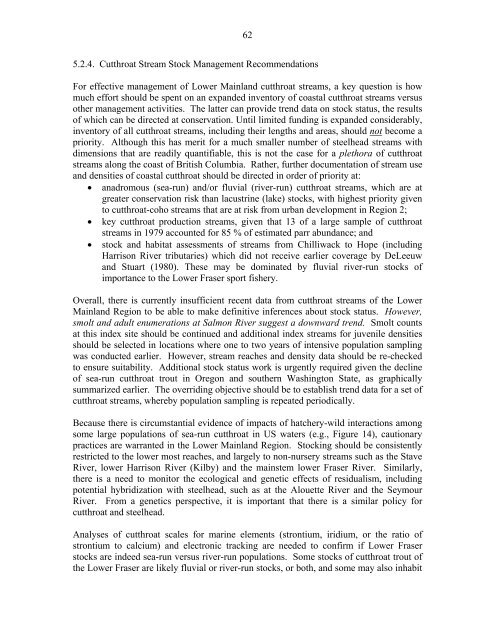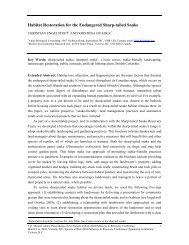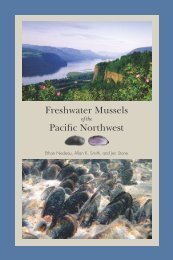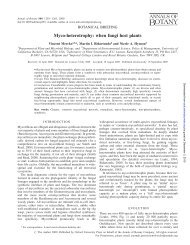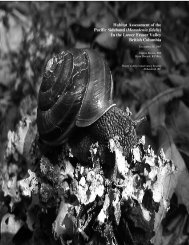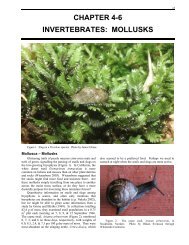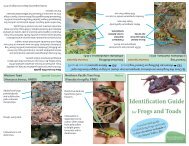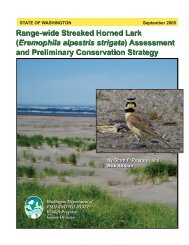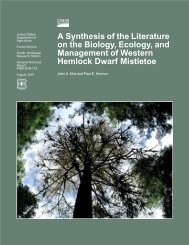Coastal Cutthroat Trout as Sentinels of Lower Mainland Watershed ...
Coastal Cutthroat Trout as Sentinels of Lower Mainland Watershed ...
Coastal Cutthroat Trout as Sentinels of Lower Mainland Watershed ...
You also want an ePaper? Increase the reach of your titles
YUMPU automatically turns print PDFs into web optimized ePapers that Google loves.
625.2.4. <strong>Cutthroat</strong> Stream Stock Management RecommendationsFor effective management <strong>of</strong> <strong>Lower</strong> <strong>Mainland</strong> cutthroat streams, a key question is howmuch effort should be spent on an expanded inventory <strong>of</strong> co<strong>as</strong>tal cutthroat streams versusother management activities. The latter can provide trend data on stock status, the results<strong>of</strong> which can be directed at conservation. Until limited funding is expanded considerably,inventory <strong>of</strong> all cutthroat streams, including their lengths and are<strong>as</strong>, should not become apriority. Although this h<strong>as</strong> merit for a much smaller number <strong>of</strong> steelhead streams withdimensions that are readily quantifiable, this is not the c<strong>as</strong>e for a plethora <strong>of</strong> cutthroatstreams along the co<strong>as</strong>t <strong>of</strong> British Columbia. Rather, further documentation <strong>of</strong> stream useand densities <strong>of</strong> co<strong>as</strong>tal cutthroat should be directed in order <strong>of</strong> priority at:• anadromous (sea-run) and/or fluvial (river-run) cutthroat streams, which are atgreater conservation risk than lacustrine (lake) stocks, with highest priority givento cutthroat-coho streams that are at risk from urban development in Region 2;• key cutthroat production streams, given that 13 <strong>of</strong> a large sample <strong>of</strong> cutthroatstreams in 1979 accounted for 85 % <strong>of</strong> estimated parr abundance; and• stock and habitat <strong>as</strong>sessments <strong>of</strong> streams from Chilliwack to Hope (includingHarrison River tributaries) which did not receive earlier coverage by DeLeeuwand Stuart (1980). These may be dominated by fluvial river-run stocks <strong>of</strong>importance to the <strong>Lower</strong> Fr<strong>as</strong>er sport fishery.Overall, there is currently insufficient recent data from cutthroat streams <strong>of</strong> the <strong>Lower</strong><strong>Mainland</strong> Region to be able to make definitive inferences about stock status. However,smolt and adult enumerations at Salmon River suggest a downward trend. Smolt countsat this index site should be continued and additional index streams for juvenile densitiesshould be selected in locations where one to two years <strong>of</strong> intensive population samplingw<strong>as</strong> conducted earlier. However, stream reaches and density data should be re-checkedto ensure suitability. Additional stock status work is urgently required given the decline<strong>of</strong> sea-run cutthroat trout in Oregon and southern W<strong>as</strong>hington State, <strong>as</strong> graphicallysummarized earlier. The overriding objective should be to establish trend data for a set <strong>of</strong>cutthroat streams, whereby population sampling is repeated periodically.Because there is circumstantial evidence <strong>of</strong> impacts <strong>of</strong> hatchery-wild interactions amongsome large populations <strong>of</strong> sea-run cutthroat in US waters (e.g., Figure 14), cautionarypractices are warranted in the <strong>Lower</strong> <strong>Mainland</strong> Region. Stocking should be consistentlyrestricted to the lower most reaches, and largely to non-nursery streams such <strong>as</strong> the StaveRiver, lower Harrison River (Kilby) and the mainstem lower Fr<strong>as</strong>er River. Similarly,there is a need to monitor the ecological and genetic effects <strong>of</strong> residualism, includingpotential hybridization with steelhead, such <strong>as</strong> at the Alouette River and the SeymourRiver. From a genetics perspective, it is important that there is a similar policy forcutthroat and steelhead.Analyses <strong>of</strong> cutthroat scales for marine elements (strontium, iridium, or the ratio <strong>of</strong>strontium to calcium) and electronic tracking are needed to confirm if <strong>Lower</strong> Fr<strong>as</strong>erstocks are indeed sea-run versus river-run populations. Some stocks <strong>of</strong> cutthroat trout <strong>of</strong>the <strong>Lower</strong> Fr<strong>as</strong>er are likely fluvial or river-run stocks, or both, and some may also inhabit


